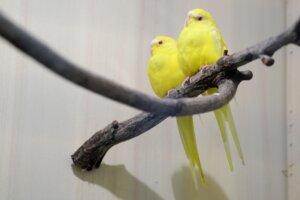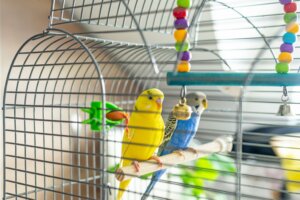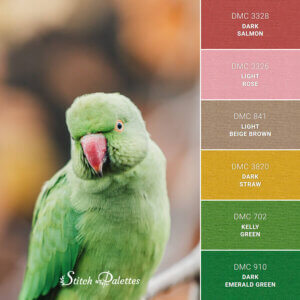White Budgie Parakeet Breeding?
White Budgie Parakeet breeding requires proper care, a healthy pair, and an ideal environment. Ensure they are mature, healthy, and well-nourished.
Breeding White Budgie Parakeets can be a rewarding experience for bird enthusiasts. Creating the right environment is crucial for successful breeding. Budgies need a comfortable, spacious cage with nesting boxes. Provide a balanced diet rich in nutrients to enhance their health and fertility.
Regularly check for signs of readiness, such as increased activity and bonding behaviors. Keep their habitat clean and free from stress to encourage natural breeding instincts. With the right care and attention, you can enjoy the fascinating process of breeding these beautiful birds and watch new life emerge.

Credit: www.thebudgieacademy.com
Introduction To White Budgie Parakeets
White Budgie Parakeets are special birds with beautiful white feathers. They are popular pets due to their friendly nature and charming looks. These parakeets are known for their intelligence and playful behavior.
Unique Traits
White Budgie Parakeets have some unique traits that make them stand out.
- Color: Pure white feathers without any markings.
- Eyes: Deep black eyes that are very expressive.
- Size: Small and compact, making them easy to handle.
- Behavior: Very social and enjoy interacting with humans.
Popular Varieties
There are a few popular varieties of White Budgie Parakeets.
| Variety | Description |
|---|---|
| Albino Budgies | Pure white with red eyes due to lack of pigment. |
| Lutino Budgies | Yellow and white combination with red eyes. |
| Recessive Pied Budgies | White with patches of different colors. |
Choosing Healthy Breeding Pairs
Breeding white budgie parakeets can be exciting. Choosing healthy breeding pairs is crucial. Healthy pairs ensure strong and vibrant chicks.
Selecting The Right Birds
Selecting the right birds is the first step. Look for birds with bright eyes and smooth feathers. Their beaks should be clean and their feet free from sores.
- Bright eyes: Indicative of good health.
- Smooth feathers: A sign of a well-cared-for bird.
- Clean beaks: No crusty build-up.
- Healthy feet: No sores or swelling.
Choose birds that are active and alert. They should move around their cages easily. Avoid birds that seem lethargic or have drooping wings.
Health Checks
Health checks are a must before breeding. A vet can provide a thorough examination. Key health aspects to check include:
| Health Aspect | Description |
|---|---|
| Weight | The birds should have a healthy weight. |
| Feather condition | Feathers should be clean and well-kept. |
| Respiratory health | No wheezing or breathing difficulties. |
| Digestive health | Check for regular and normal droppings. |
Regular vet visits help ensure ongoing health. Keep records of all health checks and vet visits. Healthy birds lead to healthy chicks.
Ideal Breeding Environment
Creating the ideal breeding environment for white budgie parakeets is essential. It ensures the health and well-being of both the parent birds and their chicks. There are several factors to consider, such as cage setup, temperature, and lighting. Ensuring these elements are optimal will help increase the chances of successful breeding.
Optimal Cage Setup
Setting up the cage correctly is crucial. A spacious cage allows for free movement and exercise. Ensure the cage is large enough to accommodate nesting boxes and perches.
- Size: Minimum dimensions should be 24x24x24 inches.
- Material: Use stainless steel or powder-coated cages. They are durable and safe.
- Perches: Place multiple perches at different heights.
- Nesting Box: Attach a wooden nesting box. Ideal size is 12x12x12 inches.
Temperature And Lighting
Maintaining the right temperature and lighting is vital. White budgie parakeets thrive in a stable environment.
- Temperature: Keep it between 65°F and 75°F (18°C and 24°C).
- Lighting: Provide 12-14 hours of light daily. Use full-spectrum bulbs for natural light.
- Night Cover: Cover the cage at night. It helps the birds rest.
Proper care of these elements ensures a stress-free breeding season. Following these guidelines will support the health and happiness of your white budgie parakeets.

Credit: www.zooplus.co.uk
Diet And Nutrition
Understanding the diet and nutrition of white budgie parakeets is crucial for successful breeding. A balanced diet ensures the birds are healthy and ready for breeding. This section will cover the essential foods and supplemental needs for these beautiful birds.
Essential Foods
White budgie parakeets need a variety of foods to stay healthy. A combination of seeds, pellets, and fresh foods is best.
- Seeds: A mix of millet, canary seed, and oat groats.
- Pellets: Pellets should be part of their daily diet.
- Fresh Foods: Include fruits and vegetables like apples, carrots, and spinach.
Always ensure fresh water is available. Clean the water dish daily.
Supplemental Needs
Besides the basic diet, white budgie parakeets need additional supplements. These supplements help in breeding and overall health.
- Calcium: Provide cuttlebone or mineral blocks.
- Vitamins: Add vitamin supplements to their water.
- Protein: Offer boiled eggs or commercial protein supplements.
A balanced diet with these supplements ensures healthy and active budgies.
Breeding Cycle Stages
Understanding the breeding cycle stages of white budgie parakeets is essential. This knowledge ensures a healthy and successful breeding process. The primary stages include courtship behavior and nesting.
Courtship Behavior
Courtship behavior is the first stage in the breeding cycle. Male budgies perform unique actions to attract females. They sing, dance, and show off their feathers. These actions help establish a bond.
Female budgies respond by chirping and fluffing their feathers. This interaction confirms their interest. During this period, provide a balanced diet to support their energy needs.
| Behavior | Description |
|---|---|
| Singing | Males sing to attract females. |
| Dancing | Males perform dances to impress. |
| Feather Display | Males show off colorful feathers. |
| Chirping | Females chirp in response. |
| Feather Fluffing | Females fluff feathers to show interest. |
Nesting
Nesting is the next critical stage. Provide a suitable nest box in the cage. The nest box should be secure and comfortable. Fill it with soft materials like wood shavings.
- Place the nest box in a quiet area.
- Ensure the nest box is clean and free from pests.
- Monitor the nest regularly without disturbing the birds.
The female will lay eggs after mating. She will incubate the eggs for 18-21 days. During this period, maintain a calm environment.

Credit: www.amazon.com
Egg Care And Incubation
Breeding white budgie parakeets is a rewarding experience. Proper egg care and incubation are crucial. This section covers signs of egg laying and proper incubation techniques.
Egg Laying Signs
White budgie parakeets display specific behaviors before laying eggs. Recognizing these signs helps in providing proper care.
- Nesting Behavior: Female budgies spend more time in the nest box.
- Increased Eating: Females eat more to prepare for egg laying.
- Frequent Visits: Females frequently visit the nest box, arranging nesting material.
Proper Incubation
Proper incubation ensures healthy chick development. Follow these steps for successful incubation:
- Maintain Temperature: Keep the temperature between 99-102°F (37-39°C).
- Humidity Levels: Maintain humidity around 50-55%.
- Turn Eggs: Turn the eggs three times daily to prevent sticking.
Here’s a quick reference table for ideal conditions:
| Condition | Ideal Range |
|---|---|
| Temperature | 99-102°F (37-39°C) |
| Humidity | 50-55% |
| Turning Frequency | Three times daily |
Following these guidelines ensures your white budgie parakeet eggs develop healthily. Happy breeding!
Caring For Hatchlings
When breeding white budgie parakeets, caring for hatchlings is crucial. These tiny chicks need special attention to grow strong and healthy. Let’s explore the essential steps to ensure their well-being.
Feeding The Chicks
Feeding the chicks is the most important task. Newborn budgies cannot feed themselves. The parent birds usually take care of feeding. If they don’t, you must step in.
- Use a special feeding formula designed for parakeet chicks.
- Feed them with a syringe or a special feeding tool.
- Ensure the formula is at a warm temperature but not too hot.
Feed the chicks every 2-3 hours during the first week. As they grow, you can gradually reduce the feeding frequency.
Monitoring Growth
Monitoring the growth of your hatchlings helps ensure they are healthy. Keep track of their weight and development daily.
| Age (Days) | Weight (Grams) | Feather Growth |
|---|---|---|
| 1-3 | 1-2 | None |
| 4-7 | 2-3 | Pin Feathers |
| 8-14 | 3-6 | Feathers start to appear |
| 15-21 | 6-10 | Feathers fill in |
Watch for signs of illness like lethargy or lack of appetite. If you notice any issues, consult a vet immediately.
Common Breeding Challenges
Breeding white budgie parakeets can be both rewarding and challenging. Knowing the common breeding challenges can help you succeed. Let’s dive into the health issues and behavioral problems you might face.
Health Issues
White budgie parakeets can face various health issues during breeding. It’s important to monitor their health closely.
- Egg binding: Female budgies may struggle to lay eggs.
- Nutritional deficiencies: Ensure a balanced diet with necessary vitamins and minerals.
- Respiratory problems: Keep their living space clean and well-ventilated.
Regular vet check-ups can help prevent serious health problems. Always keep an eye on any unusual behavior or signs of illness.
Behavioral Problems
Behavioral problems can arise during the breeding process. Understanding these issues can help manage them effectively.
- Aggression: Some budgies may become territorial or aggressive.
- Feather plucking: Stress can lead to feather plucking.
- Parental neglect: Parents may not care for their chicks properly.
Providing a peaceful environment can reduce stress and aggression. Make sure they have enough space and enrichment activities.
| Health Issues | Solutions |
|---|---|
| Egg binding | Consult a vet immediately |
| Nutritional deficiencies | Provide a balanced diet |
| Respiratory problems | Keep the cage clean |
| Behavioral Problems | Solutions |
|---|---|
| Aggression | Provide a peaceful environment |
| Feather plucking | Reduce stress factors |
| Parental neglect | Monitor chick care closely |
Preparing For New Homes
Breeding white budgie parakeets is a rewarding experience. Ensuring they move to loving homes is crucial. This section covers the steps to prepare your budgies for their new journey.
Weaning Process
The weaning process is essential for young budgies. It helps them become independent. Start by introducing solid foods. Offer a variety of seeds and pellets. Fresh fruits and vegetables are also good. Place food near the nest. Encourage them to explore and eat on their own.
Monitor their eating habits closely. Ensure they are eating enough. Gradually reduce hand-feeding sessions. This helps them rely more on solid food. Be patient and gentle during this transition.
| Weaning Tips | Details |
|---|---|
| Introduce Solid Foods | Offer seeds, pellets, fruits, and vegetables. |
| Monitor Eating Habits | Ensure they are eating enough on their own. |
| Reduce Hand-Feeding | Gradually decrease hand-feeding sessions. |
Finding Suitable Owners
Finding suitable owners for your budgies is vital. Look for responsible and caring individuals. Conduct brief interviews if possible. Ask about their experience with birds. Ensure they have the right setup at home.
Create a checklist for potential owners. Include these points:
- Experience with birds
- Appropriate cage and accessories
- Knowledge of budgie care
- Commitment to a long-term relationship
Provide them with care instructions. Explain the importance of a balanced diet. Mention the need for regular cage cleaning. Highlight the social needs of budgies. This ensures they are well-prepared for their new family members.
Frequently Asked Questions
How Do I Start Breeding White Budgie Parakeets?
Start by ensuring both budgies are healthy and mature. Provide a spacious cage, nesting box, and balanced diet. Monitor their behavior closely.
What Age Should Budgies Be For Breeding?
Budgies should be at least one year old before breeding. This ensures they are mature and healthy enough.
How Long Is The Budgie Breeding Cycle?
The breeding cycle lasts around 18 to 21 days. This includes egg laying, incubation, and hatching periods.
What Should I Feed Breeding Budgies?
Feed them a balanced diet of seeds, fresh vegetables, and protein sources. Supplement with calcium-rich foods for egg formation.
Conclusion
Breeding white budgie parakeets can be a rewarding experience. Ensure proper care and a healthy environment. Understanding their needs is crucial for success. With patience and dedication, you can raise beautiful, healthy parakeets. Happy breeding and enjoy watching your budgies thrive!
Hello Dear, I'm Poli Kolymnia, owner of many birds (including budgies).
With a deep passion for these feathered companions, I'm here to share my expertise and extensive knowledge on birds care.
My articles cover essential topics like diet, housing, care, and health, providing practical tips to help you create a happy and thriving environment for your birds.






